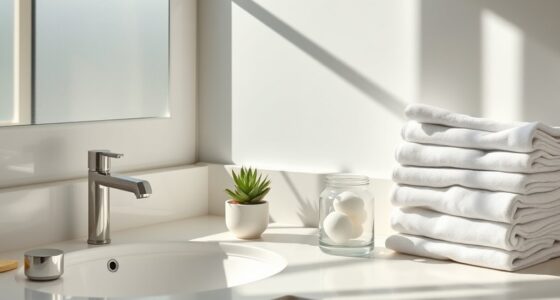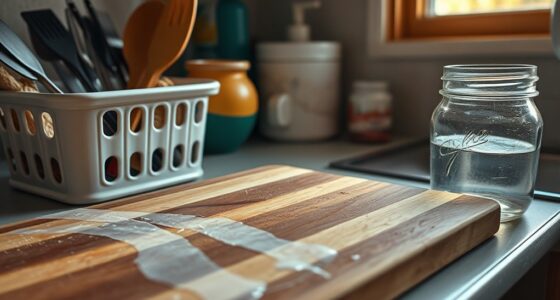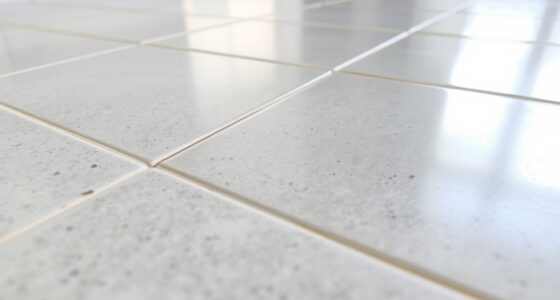To fix scratches on stainless steel yourself, start by evaluating how deep they are. For minor scratches, use a fine abrasive or stainless steel polish with circular motions, applying gentle pressure. For deeper scratches, gradually switch to coarser abrasives before finishing with a fine polish. Always keep the surface clean, work patiently, and avoid excessive force. With these tips, you can restore your surface effectively—just continue exploring for more advanced buffing secrets.
Key Takeaways
- Assess scratch depth to determine whether polishing or coarser abrasives are needed.
- Clean the surface thoroughly with a soft cloth and mild cleaner before starting.
- Use circular motions with the appropriate polishing compound, starting with coarse and moving to finer abrasives.
- Switch to a finer polish once scratches fade, and wipe the surface clean afterward.
- Finish with a stainless steel cleaner or mineral oil for shine and apply a protective layer to prevent future scratches.

Scratches on stainless steel can be frustrating, but luckily, repairing them is often straightforward. Whether the scratches are minor or more noticeable, you can often restore the surface with a few simple techniques. The key to successful repair lies in understanding how to perform industrial polishing and surface restoration properly. These methods can help you bring back the steel’s sleek appearance without expensive professional help.
Start by evaluating the depth of the scratch. Small, surface-level scratches are usually easy to fix with some basic polishing. For deeper ones, you might need to take a more cautious approach, but don’t worry—you can still achieve good results. First, clean the area thoroughly with a soft cloth and a mild cleaner to remove any dirt, grease, or fingerprints. A clean surface ensures that your polishing efforts will be effective and won’t cause additional scratching.
Once clean, choose the right polishing compound. For light scratches, a stainless steel polish or a fine abrasive pad can suffice. If the scratch is more pronounced, you might need a slightly coarser abrasive, but always start with the least aggressive option. Using a soft cloth or a buffing pad, gently work the polish into the scratched surface using circular motions. This process is a form of surface restoration—breaking down the scratch’s edges and blending it with the surrounding area. Be sure to apply consistent pressure and work gradually, checking your progress frequently.
For deeper scratches, you may need to repeat the process a few times, gradually progressing to finer polishing compounds. This incremental approach minimizes the risk of further damage. When buffing, avoid excessive force—let the abrasive do the work. If you notice the scratch fading, switch to a finer polish to refine the surface and restore its shine. After you’re satisfied with the surface restoration, wipe away any residue with a clean, soft cloth.
To give your stainless steel a polished look, consider finishing with a dedicated stainless steel cleaner or a tiny amount of mineral oil. This step enhances the shine and provides a protective layer that can help prevent future scratches. Additionally, proper maintenance and gentle handling are essential for preserving the surface’s appearance over time.
Remember, consistent maintenance and gentle handling are key to keeping your stainless steel surfaces looking their best. In essence, fixing scratches on stainless steel doesn’t have to be complicated. By understanding the principles of industrial polishing and surface restoration, you can effectively buff out scratches and restore your steel’s sleek appearance. With patience and the right tools, you’ll be surprised how much you can improve your stainless steel surfaces on your own.
Frequently Asked Questions
Can All Scratches Be Removed From Stainless Steel Surfaces?
Not all scratches can be fully removed from stainless steel surfaces, especially deep ones. Surface etching caused by harsh abrasives or chemicals often leaves permanent marks, and scratches that penetrate protective coatings may require professional help. However, minor surface scratches can often be buffed out using DIY methods, restoring shine and minimizing appearance. Just be cautious, as aggressive buffing might worsen surface etching or damage protective coatings.
What Home Tools Are Safest for Buffing Stainless Steel?
When buffing stainless steel, be brave but cautious. Begin with gentle tools like soft abrasive pads and mild polishing compounds to prevent damage. Avoid harsh abrasives or steel wool, which can worsen scratches. Carefully choose safe, simple solutions that safeguard your surface’s shine. Using these tools thoughtfully, you’ll buff away blemishes without damaging your stainless steel, making your surface sleek, shiny, and scratch-free with ease.
How Long Does a Typical Stainless Steel Scratch Repair Take?
The time it takes to repair a stainless steel scratch varies, but usually, it takes about 15 to 30 minutes if you’re focusing on surface polishing and scratching prevention. You’ll want to carefully buff the area with appropriate tools, avoiding further damage. Proper surface polishing not only fixes scratches but also helps prevent new ones. Take your time, follow steps carefully, and you’ll restore your stainless steel in no time.
Will Buffing Damage the Stainless Steel Finish?
Buffing generally won’t damage your stainless steel finish if you practice buffing safety and use the right techniques. The impact depends on your stainless steel types and how gentle you are. For delicate surfaces, apply light pressure and use a soft cloth. Always test a small area first, and avoid overbuffing. Proper care guarantees your stainless steel remains shiny without risking scratches or dullness from aggressive buffing.
Are Professional Repairs Necessary for Deep Scratches?
Think of deep scratches as dents in a mirror; surface reconditioning requires more than just a gentle polish. You might try DIY methods, but for deep scratches, professional tools are essential to restore the finish without causing further damage. These tools can carefully level the surface, ensuring a smooth, uniform look. While minor scratches are manageable at home, deep ones often demand professional repairs for a seamless, long-lasting fix.
Conclusion
Now that you know some simple DIY buffing secrets, fixing scratches on stainless steel is easier than you thought. Did you know that stainless steel accounts for about 70% of all metal used in household appliances? With just a few tools and a little effort, you can restore your surfaces and save money. So go ahead, give your stainless steel a polished, scratch-free look — you’ve got this!









